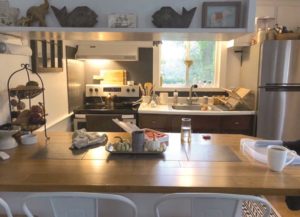Her 600-square-foot house is not technically a “tiny house,” says Hannah Oakland. “But it’s a mini. I like to say it’s a house where expectation management comes into play.”
The compact dwelling, in North Eastham, is part of one of those Outer Cape compounds where cottages sprang up alongside houses as families grew. Oakland and Al Cestaro fixed up one cottage together and for years they rented out the second one. Now, with two small children, Noble, age 3½, and Jude, 9 months, they’re expanding operations into the cottage next door.
Oakland wanted to apply the lessons learned in improving the first cottage, where removing a low ceiling opened things up nicely. “But moving into the place we’d been renting out was sobering,” she says. It was built in 1972 and hadn’t been updated since.

Without much of a budget to work with, Oakland prioritized the part of the house that mattered to her most: the kitchen. She learned quickly that even in a small space — hers is about 5 by 8 feet — it’s still possible to spend a lot of money.
“One of the biggest problems for me at first was that I wanted instant gratification,” Oakland says. She found she could assuage that desire by focusing on compiling ideas. She watched projects take shape on Instagram and at friends’ houses, which also served as a reality check on the amount of time renovation takes.
“I’ve grown to love the fact that it’s never done,” Oakland says, “It’s kind of a metaphor for life in general.”
In the kitchen, Oakland saw a lot she wanted to change. The cabinets had been painted over many times, and the countertops were made from repurposed linoleum flooring. What bothered her most, she says, were cabinets that hung over the kitchen peninsula.
“I took a sledgehammer to those first,” she says, and when she did, she had a much more useable work surface. The whole room opened up. The revised kitchen has no upper cabinets at all.
Oakland added open shelving on one side. They’re 2-by-10s, painted white, and they “float” on the wall. She knows the downside: you have to clean things more often. Having fewer cabinets has helped her accumulate less. “It turns out you don’t really need two dozen glasses,” she says. “So, there’s actually not as much to clean.”

One trick that keeps the shelving looking neat: pantry staples that can be bought in bulk go into big mason jars to eliminate the jumble of labels and packaging that might otherwise clutter the space. Stacks of plain white plates and cups also streamline what’s in view.
Oakland swapped out the cabinets under the peninsula, choosing ready-made ones that were affordable, then painting them to match the older ones that stayed in place. The set of new cabinets provides pantry drawers that Oakland finds convenient.
She also took a middle road with the appliances. Given the space constraints, there was no place to relocate them. “Sometimes a limitation helps — having fewer options makes life easier,” she says. Oakland replaced them with up-to-date versions. “They’re not my dream appliances, but they’re so much better than they were.”
Oakland works for Sustainable CAPE and values buying from local farmers markets. It’s an approach that works well if you have a small fridge and limited pantry space.

New stone countertops are expensive, but if your kitchen is small, you can shop for remnants left over from bigger jobs and sold at better prices. For the peninsula, Oakland found a piece of engineered quartz that looks like marble. “It’s another situation where having fewer choices is actually a help,” Oakland says. “You say, OK, these are my four options — which do I like best?”
The rest of the counters are butcher block. The piece Oakland bought at Lumber Liquidators was affordable, “but giant.” The solution was to go in on it with a friend who will use half. The wood provides a warm, organic counterpoint to the clean white finishes she picked for most of the room.
In the other cottage, Oakland finished a butcher block counter with polyurethane, thinking she’d never let herself cut on it. That was a mistake, she said. Sometimes, you will not be able to help yourself. If you finish it with oil, you can sand and retouch the finish easily.
The tiny house movement has been a source of ideas about making things work in this small space. Oakland looks at Brent Heavener’s @tinyhouse feed on Instagram and @thatgrackle. But she especially appreciates @angelarosehome and others that advocate doing things yourself.
While she says she couldn’t have completed these renovations without help from extended family who have building skills to lend, Oakland has done some of the work herself.
“I think women, in particular, get this idea we have to call in a specialist,” Oakland says. Working on the house has taught her otherwise, and she likes spreading the word.
“I have a friend who is a badass landscaper,” she says. “She operates high-powered machinery every day.” And yet, Oakland says, her friend could not imagine changing out a light fixture.
“ ‘Come on,’ I told her, ‘it’s three wires. We’re going to do this.’ ”
For all she’s done, “Yes, there are times I want a larger space,” Oakland says. But her place takes no time to clean. And you can’t hide from things — it’s good for family communication.
Besides, Oakland says, “I didn’t move to the Cape to spend a bunch of time inside my house.”
